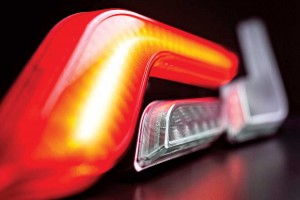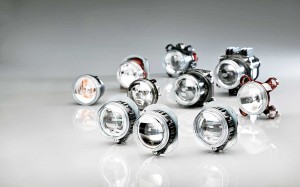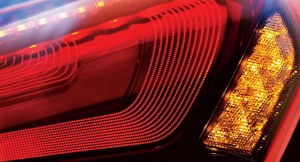Bus lighting technology is changing in-line with the need for better illumination and safety as speeds rise.
Story by: Bhargav TS
Hella showcased its Shapeline modular lamp series at the recent IAA Commercial Vehicles Show (2016) at Hanover, Germany. The series is a modular design, and includes tail lights, brake lights, direction indicators and position lights. Available in different designs, the Shapeline modular lamp series is designed to suit different commercial vehicles; of different sizes and nature. Designed to address multi-volt requirements (12-volt and 24-volt), the Shapeline modular lamp series is based on two different design
lines-classic straight line tech and dynamic curved style. In either design line, the micro-optics on the interior and exterior lense make for a homogeneous appearance turned on and when turned off. Reflective of Hella’s emphasis on modular lighting technology, the Shapeline modular lamp series for commercial vehicles open up a new world of design possibilities for bus body designers and manufacturers.
For bus lighting, the modular front lighting system does not just let the customer choose, it offers an array of design and placement possibilities. The system is made up of an auxiliary high beam, fog lamp, bi-xenon low and high beam, and static bend lighting as well as a position light. The modular lighting technology for tail lamps also provides a whole lot of design possibilities. These include themes such as futuristic, dynamic, sporty, elegant and classic. What makes it interesting as a technology is its capability to accommodate either, bulbs or innovative LED lighting. Promoting Hella’s modular lighting technology for commercial vehicles in India is the Indian operation, Hella Indian Lighting (HIL). HIL caters to the needs of diverse lighting system requirements of the automotive industry in India. It specialises in three areas – lighting for OEMs, for the aftermarket and electronics.
Built around a chip
An interesting bit about Hella’s modular lighting system is that it is built around a chip. Like an electronic gadget that contains an Intel chip inside it as the central architecture around which the other systems are designed and engineered, the modular lighting system of Hella has a chip at its centre. Expresses Ramashankar Pandey, Managing Director, HIL, that the design may vary according to the needs of the customer, the technology inside is the same. He adds, “We are working on a modular concept that is applied in Germany. The concept is slowly catching up, and we are offering it here in India. There’s been no compromise; the technology is the same, the reflector is the same and even the lighting part of it is the same. The output too is the same. It is just that the manufacturing location has changed.” Unlike the head lamp designs currently found in Indian commercial vehicles, and which have the high beam and the low beam in a single reflector made of sheet metal apart from a soda lime lense, the modular lighting system that HIL is promoting has a reflector that contains a die cast aluminium casing. The electronics are integrated and the polycarbonate cover lense is stone impact-resistant. “Functions like high beam, low beam and fog lamp are separate. If the customer needs it as a package, we can semi-customise it,” explains Pandey.
Modular lighting tech for interior and signature lighting
The modular lighting system is also being extended to interior lighting applications. This is in-line with the LED tech the company is focusing on. For designers and developers to experiment with the light signature of their vehicle and configure their own lighting design for the front, side and rear end with the click of a mouse, Hella has developed an online configurator for the new series. A vehicle silhouette is selected and different LED modules are dragged individually to the preferred position on the vehicle. The configurator automatically takes into account either current European ECE R48 regulations or American SAE regulations. Designers and developers can download the finished configuration as a PDF file or send a request to Hella customer service centre from within the system.
Extending the current 90 mm module by including an additional LED range called the L4060 series, the modular lighting technology has come to cover a wide range of applications. It has come to provide different light functions. The L4060 series is exceptionally tough and can cope with heavy stresses. Capable of converting existing halogen modules to LED modules within the framework of compatible assembly solutions, the ultra-compact design makes for incredible application versatility. Especially in combination with the benefits associated with LED lighting technology like low fuel consumption, low power consumption, reduced CO2 emissions and zero maintenance. LED lighting tech’s passive cooling among other things offers some distinct advantages, including those that are mentioned above.
Euro tech pilots India
An interesting part about the migration of lighting technology between Hella Europe and HIL is that the European technology pilots India. Strategies are formulated to drive down cost through frugal engineering. Hella, interestingly, has localised many parts except the lense, which is critical to the reliability and functionality of the system. The lense, avers Pandey, requires much investment to manufacture locally. The current volume levels are supportive of such a move. If an OEM is looking for higher technology with a thermal proof lense, the same are imported from Taiwan or China. For city buses and coaches, Hella has developed a visually distinctive stop light function. By using innovative light guide technology, the brake signal is transported from the centre section which is equipped with LEDs to the outermost points of the light which produces a special signal pattern and a striking rear design. The virtually maintenance-free integrated LEDs have a long service life (approximately 15,000 hours).
In order to increase the application versatility, the stop light product is available in two sizes – 446 mm and 638 mm. The LED additional stop lamp with IP 67 degree of protection is designed for horizontal surface mounting, and can be quickly and easily attached without screws using adhesive which forms a reliable bond. About technology evolution and fitment in India, Pandey opines that there are numerous advantages in adapting LED technology. “Filament-based technology emits only eight-per cent of the light. Much energy is wasted in heating up the filament,” he adds. The advent of the LED technology in projector lamp has helped to package five solutions in two modules. Following the modular postulate to arrive at a platform concept, the company, based on the needs of the customer, can mass customise it. Hella is employing the modular postulate to arrive at a platform concept for the bus segment too.
Platform concept
Platform concept presents design freedom. It is paving the way for use of technology in different ways. The lamp thus takes different shapes despite the source being the same. Points out Pandey, that Hella is the only company, which is investing in developing technology and distributing it. “We also customise it as per the needs of its clients,” he adds. Stressing upon Hella wanting to play in the bespoke zone and render a variety of products that match the needs of the customers, Pandey avers, “The need to perform in a volume market was striked off. It was decided that customers will not be lured by cheap prices. Our competitors will run the show with five or six mega projects. Our manufacturing lines are highly flexible. We have 15 to 20 projects progressing concurrently.”
In the area of signature lighting, Hella is ready to serve the needs of the customers. It has essential functions in place to cater to issues like safety. Mentions Pandey that the speed at which buses are currently operated, there is a definitive need for advancement in lighting technology. This is especially necessary to support longer vision, he adds. The increase in wattage power of the bulb will not serve the puropse he feels. He therefore states, that such a measure actually makes the lighting system counterproductive. “It is the module which has to be changed, and which in turn calls for design and reflector change,” he adds. The projector module serves the purpose. The reflector along with the module has a cover lense. There’s another lense inside, which amplifies the light. The technology can be customised for variety of different applications. The design supports safety, especially in front lighting.
LED tail lamps
LED tail lamps add to the safety of the vehicles, and buses are no exception to it. India is yet to warm up to LED tail lamps. Used in buses, it can warn other road users by providing, enough braking distance. A big advantage of LED tail lamps is the very short time they take to light up. LEDs glow instantly, giving close to four metre of braking distance for the vehicle following. Claiming to have worked out the cost equation, the average cost per LED tail lamp, according to Pandey, comes to around Rs. 3000. The lamps are maintenance free, and could be offered with a five year warranty. Replacing the bulb in an normal lamp that costs Rs. 350 takes the cost to Rs. 600 per year The user tends to spend Rs. 950 for five years. The cost would be approximated Rs. 4750. In the longer run, LED light is beneficial, mentions Pandey. He states. “We want to be the supplier of choice for LED signalling, modularisation and projectorisation of front lighting in commercial vehicles. We are commencing our first phase of rear light production by October 2016.” Apart from lighting systems, Hella India is also into switches. “We are capable of supporting interior lighting. Volume-wise, trucks may amount to more, it is buses which are contributing handsomely. This is partly because the rate of technical adaption in buses in more than in trucks,” says Pandey.
In the Bus & Coach segment, Hella is catering to the requirements of almost all the bus manufacturers in India. It also catering to clients abroad. The client list of the company includes Volvo, Scania, Mercedes-Benz, Wright Bus, EvoBus, Vanhool, Yutong, Temsa, Ashok Leyland, Tata Motors, JBM, Solaris, VDL, and others. Serving off-highway equipment segments as well, Hella exports locally made LEDs to USA, Singapore, South Africa, Australia, Germany, UAE, and other markets. As a social responsibility, the company is contributing toward road safety. It is keen to see a 10 per cent reduction in road accident deaths in India by 2020. From its research, says Pandey, the company discovered that an important aspect, which did not catch the attention of most while addressing road deaths involving commercial vehicles is the ability to recognise moving traffic and objects on the road. “Lighting is playing an important role to ensure this crucial element of recognition to avoid fatal road accidents. It is very important ‘to see’ and ‘to be seen’ to avoid road fatality in emergency situations while driving on Indian roads,” avers Pandey. He signs off, “We believe that we should first have proper lighting and signalling system for proper vision and avoid creating millions of accident situations. We can then work on other safety features, which are also critically important when an unavoidable accident situation occurs.”
caption
ñ LED tail lamps enhance safety by lighting up quickly.
ð Signature lighting is made possible by Hella’s efforts to offer solutions that support greater design freedom.
ð As speeds rise, head lamp technolgy is changing in search of better illumination. Projector lamps could well be the answer.
ò Oue conventional bulbs, LED are cost effective and far more reliable.































